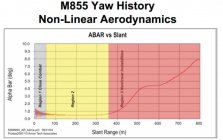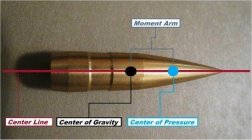New Formula for Gyroscopic Stability of Open Tipped Match Style Rifle Bullets
A paper describing our new formula for the gyroscopic stability of open tipped match bullets has just been published by Cornell University Library. Don Miller knew that the assumption of constant density used to develop his original twist formula would tend to underestimate the stability of open tipped match bullets, and he shared some very good ideas which proved useful in formulating a more accurate equation. I have attached a spreadsheet implementation of the new formula, along with the previous formulas for constant density bullets and plastic tipped bullets.
http://arxiv.org/ftp/arxiv/papers/1401/1401.4187.pdf
Abstract: Earlier work has produced formulas for predicting stability of rifle bullets of near uniform density and also for plastic-tipped rifle bullets. These formulas have been shown to be accurate to within 5%. However, the original Miller twist formula for metal bullets of near uniform density underestimates the stability of match style open tipped rifle bullets having a significant empty volume in the tip. This paper presents a new formula for accurately estimating the stability of these open tipped match style rifle bullets from parameters easily obtained such as the bullet mass, length, and depth of the empty space in the tip. The formula is tested by measuring the aerodynamic drag vs. predicted stability of several bullets over a range of stabilities.
A paper describing our new formula for the gyroscopic stability of open tipped match bullets has just been published by Cornell University Library. Don Miller knew that the assumption of constant density used to develop his original twist formula would tend to underestimate the stability of open tipped match bullets, and he shared some very good ideas which proved useful in formulating a more accurate equation. I have attached a spreadsheet implementation of the new formula, along with the previous formulas for constant density bullets and plastic tipped bullets.
http://arxiv.org/ftp/arxiv/papers/1401/1401.4187.pdf
Abstract: Earlier work has produced formulas for predicting stability of rifle bullets of near uniform density and also for plastic-tipped rifle bullets. These formulas have been shown to be accurate to within 5%. However, the original Miller twist formula for metal bullets of near uniform density underestimates the stability of match style open tipped rifle bullets having a significant empty volume in the tip. This paper presents a new formula for accurately estimating the stability of these open tipped match style rifle bullets from parameters easily obtained such as the bullet mass, length, and depth of the empty space in the tip. The formula is tested by measuring the aerodynamic drag vs. predicted stability of several bullets over a range of stabilities.












